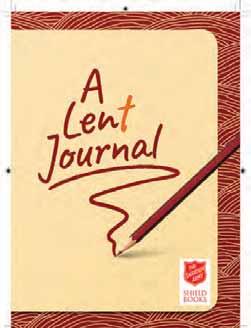
3 minute read
My journal
Freedom to think
To mark the publication of A Lent Journal, four people reveal how journaling helps them connect with God – this week, Deputy Director of Family Ministries Liz Hall (THQ)
IN the summer of 2020 I went to the Creative Christianity summit and joined a session on Bible journaling. I thought, ‘That feels good, I’ll give that a go.’ So, I got into what is called messy journaling, where your thoughts inspire a picture.
My inspiration sometimes comes from listening to a podcast that captures my imagination and makes me feel like I want to journal in a creative way. I’ve got a notebook that I use, as well as acrylics, watercolours, pencils and stuff to stick and glue. After decorating the page, I’ll either write or print something that reminds me why this page came about.
I think there is a big element of reflection in journaling. I am very extroverted, but I have discovered in the past three years that I need space to sit and mull things over. Being busy with my hands helps free my mind to go off at a tangent. For instance, there might be a piece of Scripture that stays with me that I play with in my mind and pray about as I’m drawing.
Journaling is a tool for my own personal spiritual development, but it also includes my praying and my Bible reading, as well as other reading.
I have an Instagram page, which is @Cerulean_Socks, where I post some of my journal entries. I’ve also got a Facebook page dedicated to journaling and I went through a phase of journaling live so that people could see the process online. That’s because I very much want other people to join in and find what I’ve found: the freedom that comes with journaling.
It keeps my hands happy and it enables me to think more deeply about things I wouldn’t have time to think about if I weren’t doing that. It’s nice to look back on the entries and see where God has been faithful or be reminded of a recurring motif or Scripture.
I use ordinary shop-bought notebooks, but you can also buy journals that are pre-prepared to give you things to think about. In A Lent Journal, I like that there are Bible verses and song lyrics to prompt you. For instance, there’s one page that has the line: ‘I believe that God the Father can be seen in God the Son.’ That song jumped out at me, and I’ve got an idea of how I want to capture my thoughts around that.
Lent itself is a time of getting ready, a time of preparation. One year I tried to do a watercolour painting every day for 40 days. Towards Easter they got very Scripture-focused, with my thoughts and prayers centered around that.
While I’ve been journaling, I’ve been trying to set aside time each day for it, so that means when Lent comes it won’t feel like a chore. I’ve already set time aside to do something, and Lent will be 40 days of focus towards preparing for the celebration as well as the grief and bereavement of Easter.
To those who haven’t journaled before, I would say just start – even if it means simply writing down whatever is in your head when you wake up in the morning. People often think that journaling has got to be deep or profound, but it can be what you need it to be.
Maybe have a pad and a pen by you when you pray. You could write down in your time of prayer how you feel God is communicating with you in your thoughts, as well as the way you feel and the things distracting you. Write those down as well because they’re markers of a time when you were with God, either when it was easy to engage with him or it wasn’t.
To Salvation Army officers who are maxed out – already setting time aside for Scripture, prayer, study and sermon writing – I’d say don’t carve out more time, use the time you’ve already got. It’s about enriching what you’re already doing.
Journaling doesn’t work for everybody. But it will resonate with some people and can become part of their spiritual discipline. So give it a go and see what happens.


A Lent Journal is available from
sps-shop.com/books
for £5 (plus postage and packaging)








